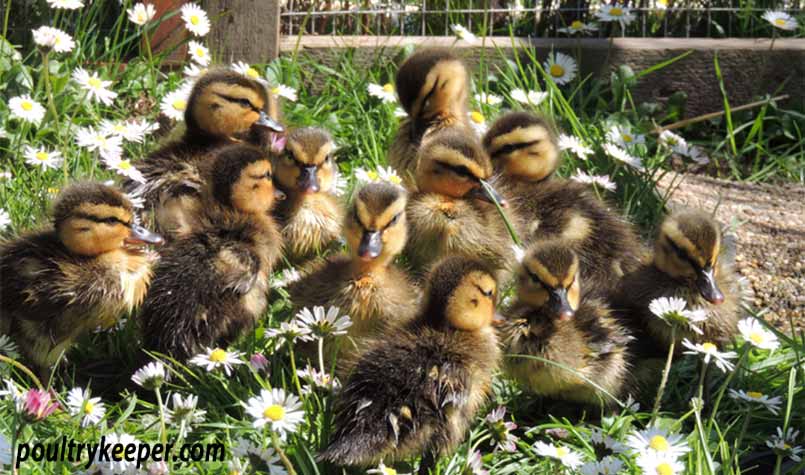
Note:
This article on how to care for wild baby ducks pertains to wild Mallard ducklings only. Domestic breeds of duck require different types of care.
There is information on feeding domestic ducklings here.Mallard ducklings are more likely to be found in the first 24 hours after hatch as the mother may have to lead them a fair way to water resulting in a few getting left behind. During the first week, out of a clutch of 12, she is likely to lose most of them. Most mallard mums will end up with 2-4 ducklings surviving to adulthood.
Although ducklings get straight onto the water after they have hatched, they will have already benefited from being waterproofed by their mother. Ducklings with no mother have to work much harder to waterproof themselves. You, therefore, need to exercise caution regarding any water they may be able to enter. A waterlogged duckling can drown or die from hypothermia surprisingly fast.
The first 24 hours
After they have hatched, the ducklings survive for 24 hours on the yolk sac they have absorbed just before hatching. Consequently, they may not be interested in eating or drinking during the first few hours after rescue. They do, however, need to be kept dry and warm until they are ready to eat.
Rearing
If you can’t get your duckling(s) to an experienced person, keep them in a medium-sized, high sided box, with a hot water bottle under a towel at one end.
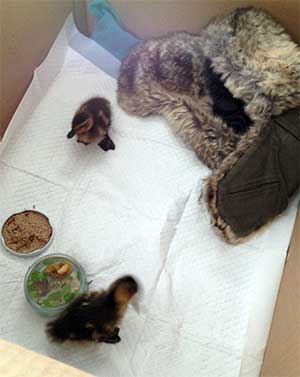 They will benefit from somewhere to snuggle where they can keep warm – a furry hat with ear flaps, placed over a covered hot water bottle is ideal, but do make sure they can get away from the hot water bottle if they want to. A duckling can also suffer from overheating as well as being cold. Don’t leave the duckling(s) in direct sunlight, behind a window with no shade or ventilation.
They will benefit from somewhere to snuggle where they can keep warm – a furry hat with ear flaps, placed over a covered hot water bottle is ideal, but do make sure they can get away from the hot water bottle if they want to. A duckling can also suffer from overheating as well as being cold. Don’t leave the duckling(s) in direct sunlight, behind a window with no shade or ventilation.
Occasionally, ducklings may benefit from being kept close to your body to keep warm if you can’t get them set up properly when they are first rescued. If the duckling is wet, use a soft towel/cloth, and dry until its down is fluffy again.
Bedding
Routine
Try not to leave the ducklings unattended for more than 2-3 hours at a time. Nigh time is an exception but they will be up when it is light.
During daylight hours ducklings will have a routine of eating and drinking then preening then snoozing on an hourly basis (approximately)
If the duckling needs first aid, a solution of sugar water can be offered from a dropper into the end of its beak or in the nook/well of your thumb and forefinger. Do not syringe feed a duckling you may get liquid in its airway.
Feeding
For food, offer a jam jar lid with a small amount of hard boiled egg or crushed dried mealworms, crumbled with chopped oats. Also provide a shallow dish of water filled with pebbles. The pebbles protect against the duckling getting into the water where it could get waterlogged, or even drown. Never offer food without water.
Handling
Don’t hold a duckling too tightly. Ducks have a complex respiratory system and have air sacs all around their body. Holding them too tight can cause breathing difficulties and even suffocation. Try to hold your hand gently around them, making sure there is always room for them to move around a little bit inside your hands. They are also quite bouncy so be prepared for them to try and jump out of boxes/hands etc. onto the floor!
Injuries
If your duckling appears to be injured or has been attacked by a cat or dog please get it to a vet as soon as possible. Ducklings often have leg sprains that are recoverable, however, a duckling with a broken leg will not survive in the wild. Puncture wounds from cats can cause bacterial infections, which can kill a duckling within 48 hours. If you can see a puncture wound on the duckling please point this out to the vet. Please note that ducks have holes for ears that shouldn’t be confused for puncture wounds.
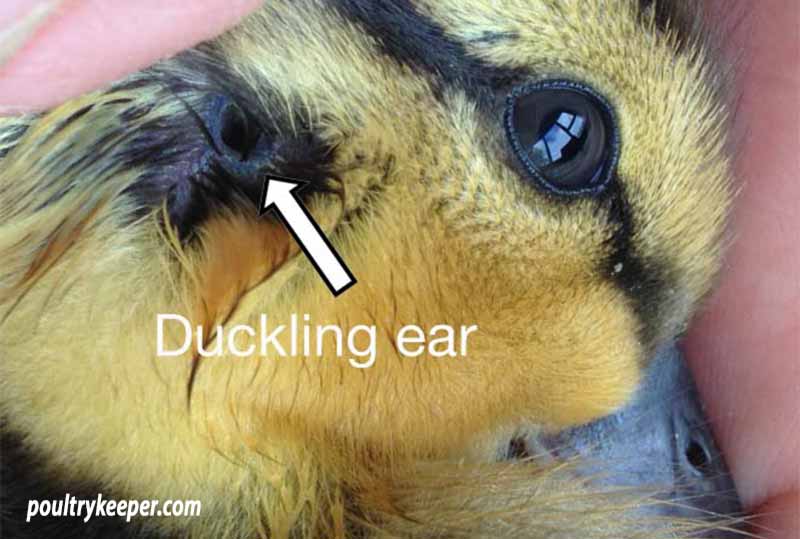
Ticks
If the duckling has been found in long grass check it for ticks. Ticks can be debilitating and need to be removed as soon as possible. They are usually located on the head and around the eyes. Please seek professional help to remove ticks if you are not fully comfortable removing them with tweezers.
This care regime can be used for 2-3 days. If you have the ducklings for a longer period, the following care will need to be put into place.
Feeding Mallard Ducklings
3 days to 5 weeks

Examples of starter crumbs suitable for ducks are:
- Duck Food Just Natural Duck Starter Crumbs 5kg by Crediton Milling
- Allen & Page Small Holder Range Goose & Duck Starter Crumbs - 20 kg
- Fancy Feed Chick Crumb 5kg
- Organic feeds baby Chick Crumb 5kg
From 3-4 weeks change over to duck and goose growers pellets, mixing the pellets in with the crumbs over about 10 days phasing out the starter crumb. Do not feed the starter crumb at all after 4-5 weeks old, as the protein content is too high.
Tip: Angel Wing
Too much protein after 4-5 Weeks of age is thought to cause the wings to develop too quickly which may result in a condition called angel wing. A wild duck with angel wing will not be able to fly, and would be unlikely to survive in the wild.
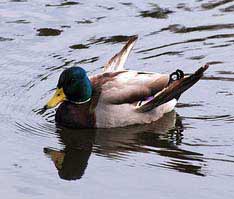
5-9 weeks
From 5-9 weeks add in some whole wheat until they are happy with whole wheat scattered on the ground, as they near release time.
From a few days old ducklings must learn to forage for food. Provide shallow dishes of pondweed/water from rivers and streams. There will be tiny crustaceans and bugs in this water, which they will forage for. Supplement the insect life with a few crushed, dried mealworms sprinkled in the weed. Clods of turf served in water will also encourage natural feeding behaviour.
Prepare for the ducklings to make a considerable mess with this feeding, but do encourage it, as it will be vital for their future survival. Use mealworms sparingly, especially after 5 weeks of age, as they are extremely high in protein.
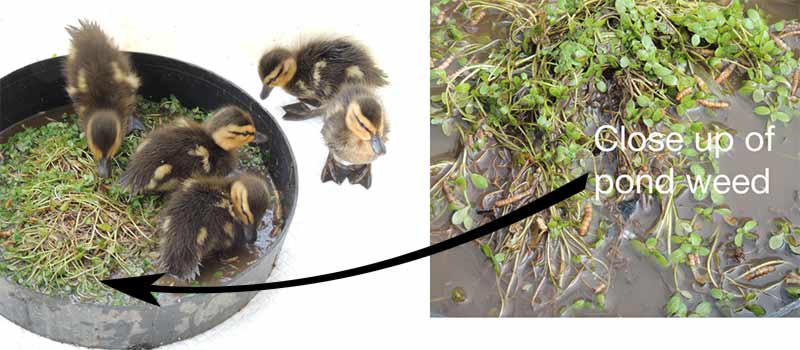
Finely shredded romaine or round lettuce and watercress should be fed if natural greens cannot be provided.
Tip: Leg Weakness
If ducklings are showing leg weakness or a reluctance to walk properly then you can sprinkle a pinch of dried brewers yeast powder on their food for a few weeks as a supplement. Brewers yeast is rich in B vitamins that ducklings need. You can buy Brewers Yeast online or in health food shops.
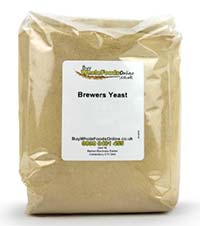
Natural sunlight (not through windows) is vital for vitamin D synthesis and good bone development. Try and let the ducklings forage outside on grass from as early and long as possible if the weather is warm enough.
Water Sources
Drinking water must always be available. If you have one or two ducklings a shallow dish with pebbles will suffice as long as it isn’t left to go dry. Ducklings not only drink but ‘use’ a great deal of water and will get through a small dish very fast.
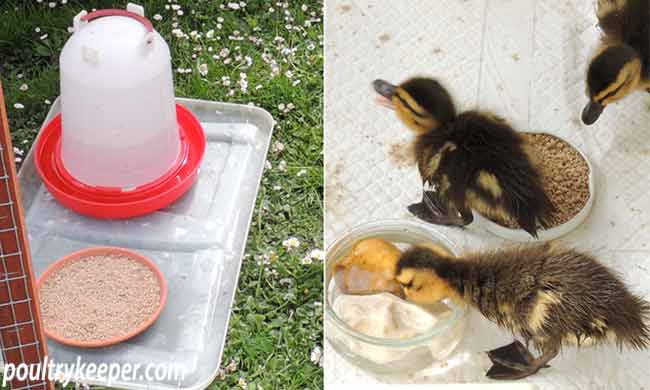 For more than two, provide a proper drinker.
For more than two, provide a proper drinker.
Putting the drinker on a plastic tray will help to stop wet bedding. Ducklings must have an area available, which remains dry.
Water is essential and must always be available. Never offer ducklings food without water.
Temperature
How to care for wild baby ducks when there is no mum to keep them warm? Well ducklings can’t regulate their own body temperature until they have feathers. You need to control their environmental temperature to ensure they don’t get too hot or too cold. Unless ducklings are outside in the sunshine with no wind chill, you will need to provide supplementary heat for the first 1-3 weeks. Ideally they need a brooder, that’s adjusted as they grow. You can also use an electric heat source or lamp.
The Brinsea EcoGlow Brooder is ideal for ducklings. The small version will be OK for up to 5-6 ducklings, the larger one if you have more. Heat lamps are also useful but need hanging from the ceiling so are not as convenient. Floor standing brooders are also much safer.
Heating while outdoors
If your ducklings are outside unsupervised for more than an hour, and are under 3 weeks old it is vital to provide them with a heat source in a dry area. Do NOT let them get wet and cold at this age.
Adjust brooders and heat lamps to the correct height as the ducklings get older. Always provide enough space for them to decide where they want to be. As a general rule, if they are huddling they are too cold, if they are panting and spread out they are too hot. Take note of their behaviour and you can adjust the temperature.
After 4-5 weeks they should not need a heat source unless you are in a particularly cold environment.
Bedding
When indoors, disposable puppy pads or towels are best. Change bedding at least daily. As ducklings get older (4-5 weeks) use chopped straw, dust free wood shavings or hemp style bedding. Never use newspaper or hay and always check that ducklings are not ingesting wood shavings or hemp if you choose this bedding. Outside time is vital and ducks should be on short grass. Avoid concrete if possible.
Indoor enclosures
For the first 2-3 days keep ducklings indoors. They need an area that they can move around in comfortably, where they can move between their drinker/food and their dry warm area.
Depending on how many ducklings you have, the area should be between 3ft x 3ft (up to 4 ducklings) to 6ft x 3ft (up to 12 ducklings). You can either buy brooder panels or you can make a high sided enclosure with stiff cardboard.
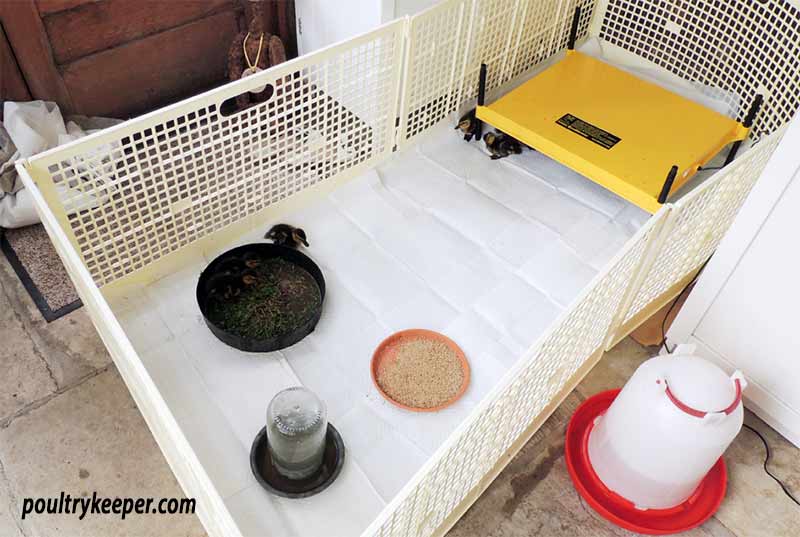
After 2-3 days they will enjoy having time outdoors. As already mentioned in the temperature section, they will need to be warm and protected from predators (ground and aerial). They must also be enclosed, so they cannot escape.
Outdoor enclosures
A 6ft by 6ft aviary is an ideal enclosure for two to six 2-3 week old ducklings. After that they will need more space, from 2-3 weeks old they will enjoy an enclosure at least 8ft by 18ft. Enclosures can be made from the fine gauge plastic garden fencing that can found in stores like B&Q and garden netting can go over the top of the enclosure to protect from birds of prey or corvids and seagulls.
Tip: Outdoor Enclosure
The outdoor enclosure needs to have space for a drinker, food dish, brooder, bathing facilities and a shallow dish of weed.
It must offer protection from wind and have a covered area to provide shade as well as protection from rain.
From 3 weeks old, wild baby ducklings can have larger gauge netting such as plastic coated chicken wire. In the UK they are less vulnerable from corvids and gulls once they reach this age, but a mesh roof may be necessary if you live in an area with birds of prey present.
Even with all these precautions it is always best to check on the ducklings at least every half hour, even in good weather. If they cannot be checked with this frequency, it is safer to bring them into their indoor enclosure.
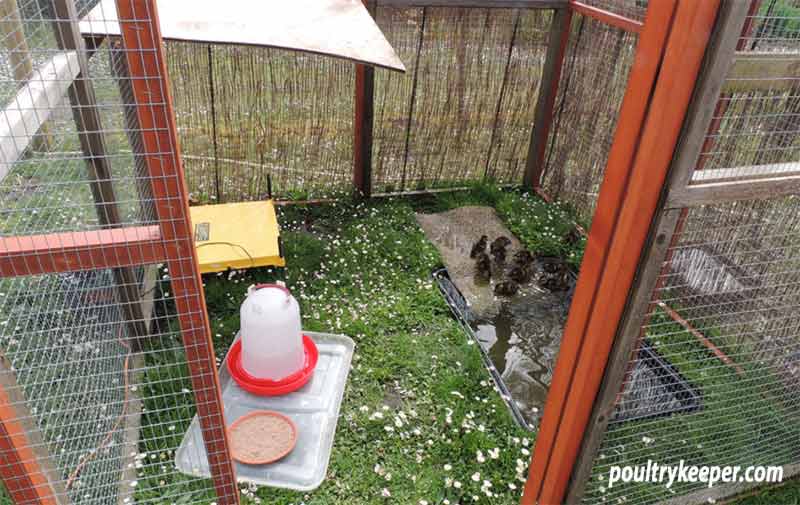
Electric brooders can be put outside and plugged into a garden extension reel providing you take the necessary steps to stop them getting wet. Shade is essential if the weather is hot.
Provision of bathing water
It is sensible to supervise ducklings up to 1-2 weeks old (or until you can see they are waterproof i.e. stay fluffy) when swimming. It is VITAL that they have an exit ramp that they can use to get out of the water.
Ducklings prefer a shallow incline to enter and exit water. Water should not be too deep. During the first week supervised bathing in the sink or bath is acceptable. Watch them at all times when bathing and let them bathe up to 5 times a day. Towel dry them then leave to preen in a warm place. Bathing and preening encourages them to use their oil gland, which will waterproof them.
Paint trays
Paint trays make excellent bathing facilities. The smaller trays for the first week and the larger ones until the ducklings are big enough to have a small pond or tub. They may need a step up into the paint tray as they can be high off the ground.
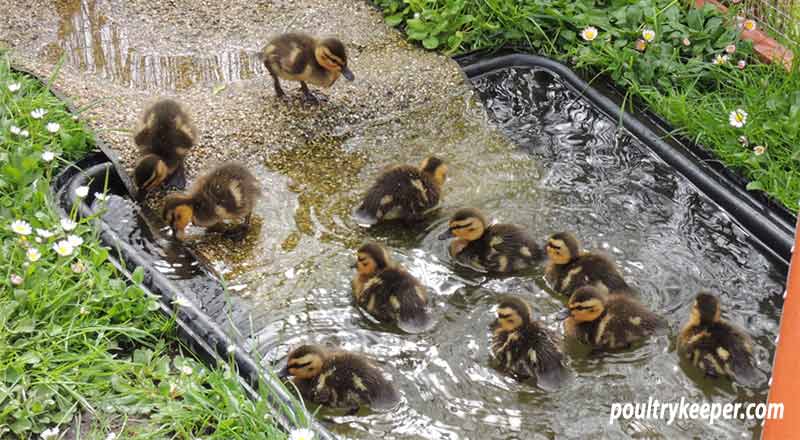
Strips of carpet are great for using as exit ramps in ponds. Stone pond liner as shown in the image below is ideal but can be expensive.
When ducklings reach 4-5 weeks, provide them with bathing facilities big enough to swim and dive and flap around in. This helps develop their wing muscles for flying. (They will still need an exit ramp).
Will the duck know it is a duck?
Imprinting in ducks is a complex subject. There are two types of imprinting: Filial and Sexual. Simply put, filial imprinting will determine what species the duckling will see as a mother figure or who to follow. This type of imprinting occurs at hatch.
Sexual imprinting
Sexual imprinting determines what the duck sees as a mating partner. This develops over a much longer period, as the duckling develops into adulthood. Generally if you have a wild mallard duckling, the first thing it would have seen when hatched, is its mother and other ducklings. It should therefore imprint on ducks, and always know it is a duck. Even if you raise that duckling with only human company for the first few weeks of its life, it should still integrate with other ducks when reunited with its own kind.
Tip: Single Ducklings
It is often the case that you find a single duckling. Place it with other ducklings as soon as possible, but if that's not possible, it can be raised on its own. Always provide a single duckling with a mirror and cuddly toy and try to avoid leaving it alone during the day.

In these circumstances, it is better to keep it with you as it needs company, ducks are flock animals and generally don’t feel secure on their own. Never release a single duckling socialising it with other ducks first. You need to seek specialist advice if you have a single mallard that has grown to adulthood with only human company.
Humanisation
Humanisation is different. Avoid letting the duckling become used to dogs and cats. It will lose its fear of them, and will be more susceptible to predation when it is older. Additionally, try not to hand feed and cuddle the ducklings as they get older. They will associate humans with food and this may affect how well they can find food in the wild.
Release
If the location of the water source where the rescue took place is known, it is always ideal to release ducklings back to where they were found. This is easy if they have been found at a local park with a pond or a quay etc. However, much of the time ducklings are found in built up areas, or places far from a pond or river.
If you cant release back to their original pond then you must ensure they are released somewhere with water where there are other ducks.
What age to release?
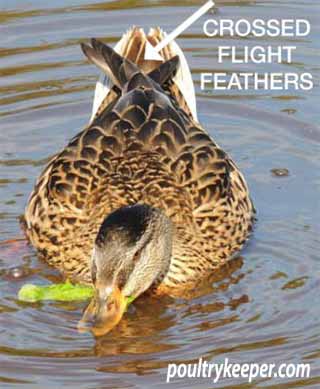 The age that the ducklings should be upon release will depend on how safe and populated the area is. Ideally they should be released when they can fly, which is between 8-9 weeks. They can be released as young as 6 weeks if they are fully feathered and the location is safe from predators – such as a pond with islands and with lots of people around.
The age that the ducklings should be upon release will depend on how safe and populated the area is. Ideally they should be released when they can fly, which is between 8-9 weeks. They can be released as young as 6 weeks if they are fully feathered and the location is safe from predators – such as a pond with islands and with lots of people around.
When released, young mallards like to tag along with older mallards to show them the way.
Please make sure you DO NOT release mallards in an area where there are no others. Any fast flowing rivers should be avoided, but a slow-flowing river which meanders through fields and marshes is ideal, as good cover and a good food source is available in such an environment.
At this age their flight feathers should be fully developed and the tips of their wings should cross over near their tail.
Feeding after release
If at all possible, you should return daily to feed them. Feed with whole wheat until they have had time to familiarise themselves with their environment. If released where humans feed other ducks, then they will adjust a lot faster.
Release first thing in the morning and take some whole wheat with you so they can feed. Stay with them until they venture onto the water. Don’t try and hustle them onto the water. At first they will be afraid; let them make their own way. This may take a few hours, so leave the day free so you can ensure they have settled onto the water.
Go back to the same spot every day at the same time, for as long as you can, to bring them wheat. Wherever you decide to release the ducks, make sure you pre-plan it. Talk to the park supervisors, rangers or land owners first so they know what you are doing. Make sure you will be able to check on them every day for a few weeks.
Do as much research as possible into release options early on. If you live within ¼ or ½ mile of a water source and are not in a built up area, let the mallards go from where you are raising them when they are ready (if you can give the time to look after them for a couple of months longer).
Flight
When their flight feathers develop they will start to practice flying and will take little test flights. They will fly very short distances at first and return home.
As they get stronger, they will fly higher and at this point they will be able to get a ‘birds eye view’ of their surrounding landscape. They will at some point go and investigate water sources.
It is likely they will keep coming home for a few weeks, then they may stay away over night, (usually during a full moon). Mallards usually take flight at dusk and dawn. They will appreciate food when they return home, but may stay away for longer and longer periods of time.
If you are lucky enough to have a pond on your garden, the mallards may decide to stay and become resident, in which case be prepared for more ducklings the next year!
Wing clipping
Do not ever clip the wings of a wild mallard, nor keep it enclosed after it can fly to ‘try and keep it safe’. Although quite used to humans in lots of areas, mallards are still wild birds. Flight is an essential part of their life.
Unless there are exceptional circumstances and the duck is disabled in some way, ALWAYS give mallards the option of flight, even though some may never fly further than the end of your garden.
Release is both the saddest and the happiest of experiences. Watching rescued mallard ducks you have raised, fly away, is a privilege few people get to experience.
Legal considerations (UK)
When you come across any abandoned or injured wildlife you need to be aware of legal considerations. Without going into detail you must never take an animal from the wild unless you are 100% sure it is injured, abandoned or orphaned.
Ducklings often get separated from their parents and are often on ponds or grass alone. Their mum may not be anywhere in sight. Leave them alone unless:
- Injured
- Cold and wet
- Out of water / sinking in water
- Being attacked or is in imminent danger
- Found in an isolated area with no other ducks around
If you are concerned please try and watch it for at least 2 hours before you remove it. A ducking should look fluffy, rather than wet and slick.
Once you have them, you must go to reasonable lengths to get them professional care at either a vets or a wildlife rescue organisation. You must not release a duckling back into the wild until it is able to survive on its own.
If the duckling is on private land try and seek permission from the land owner.
Sexing Mallards
Mallards all have the same plumage until about 7-9 months old when the drakes develop colourful feathers. You can tell their sex from about 8 weeks old by their voice.
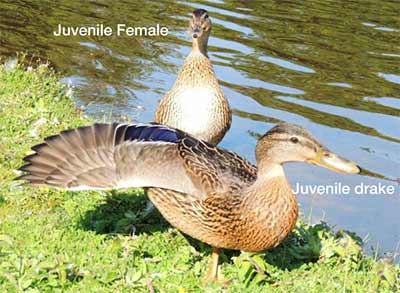
The drakes have a nasal ‘raab’ sound, and the females have the more traditional quack. Drakes also tend to develop a greenish hue with black to their bills, while females are more orange/yellow with black.
Are you interested in seeing photos of the many breeds of domestic ducks? Then check out our Duck Breeds photo page.
There are also many other articles about keeping ducks in this section, including our Beginners Guide to Keeping Ducks.
I hope you found this guide on how to care for wild baby ducks useful. Please leave a comment below and tell me how you got on!

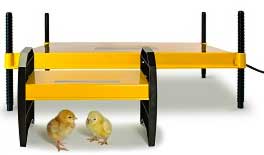




Social requirements and imprinting